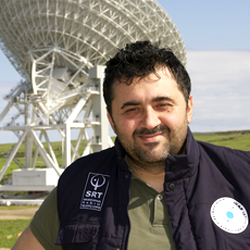Sergio Poppi
Ricerca astrofisica e ICT: Il Sardinia Radio Telescope
 Sergio Poppi si è laureato in Astronomia presso l'Università di Bologna. Dal 2002 al 2005 è stato ricercatore presso l'Istituto di Radiostronomia CNR/INAF nell'ambito del progetto Sky Polarization Observatory dove si è occupato acquisizione dati e telemetria per voli da pallone stratosferico di lunga durata.
Dal 2006 è Tecnologo presso INAF - Osservatorio Astronomico di Cagliari, dove si lavora sullo sviluppo del software di controllo e sulle tecniche di metrologia per le misure delle deformazioni delle ottiche del Sardinia Radio Telescope. Da agosto 2018 è cordinatore della squadra operativa di SRT come responsabile delle operazioni di SRT. Inoltre, conduce ricerca astrofisica relativa allo studio del mezzo interstellare e dell'abbondanza di elementi chimici in nubi protostellari, come si può evincere dal profilo ORCID disponibile al seguente link: https://orcid.org/0000-0002-4698-2607.
Sergio Poppi si è laureato in Astronomia presso l'Università di Bologna. Dal 2002 al 2005 è stato ricercatore presso l'Istituto di Radiostronomia CNR/INAF nell'ambito del progetto Sky Polarization Observatory dove si è occupato acquisizione dati e telemetria per voli da pallone stratosferico di lunga durata.
Dal 2006 è Tecnologo presso INAF - Osservatorio Astronomico di Cagliari, dove si lavora sullo sviluppo del software di controllo e sulle tecniche di metrologia per le misure delle deformazioni delle ottiche del Sardinia Radio Telescope. Da agosto 2018 è cordinatore della squadra operativa di SRT come responsabile delle operazioni di SRT. Inoltre, conduce ricerca astrofisica relativa allo studio del mezzo interstellare e dell'abbondanza di elementi chimici in nubi protostellari, come si può evincere dal profilo ORCID disponibile al seguente link: https://orcid.org/0000-0002-4698-2607.
 Sergio Poppi graduated in Astronomy at Università di Bologna. From 2002 to 2005 he was a researcher with the CNR/INAF Radioastronomy institute and took part in the Sky Polarization Observatory project, where he worked on data acquisition and telemetry for long-lasting stratospheric balloon flights.
Since 2006 he is with INAF as a Technologist at the Astronomical Observatory in Cagliari, where he works on the development of the control software and on the metrology techniques for the measurement of the optical deformations of Sardinia Radio Telescope. From August 2018 he is the coordinator of the SRT operations team. Moreover, he conducts astrophysical research related to the study of the interstellar medium and the abundance of chemical elements in protostellar clouds. Further information on this research is available on his ORCID profile: https://orcid.org/0000-0002-4698-2607
Sergio Poppi graduated in Astronomy at Università di Bologna. From 2002 to 2005 he was a researcher with the CNR/INAF Radioastronomy institute and took part in the Sky Polarization Observatory project, where he worked on data acquisition and telemetry for long-lasting stratospheric balloon flights.
Since 2006 he is with INAF as a Technologist at the Astronomical Observatory in Cagliari, where he works on the development of the control software and on the metrology techniques for the measurement of the optical deformations of Sardinia Radio Telescope. From August 2018 he is the coordinator of the SRT operations team. Moreover, he conducts astrophysical research related to the study of the interstellar medium and the abundance of chemical elements in protostellar clouds. Further information on this research is available on his ORCID profile: https://orcid.org/0000-0002-4698-2607
SESSIONE 8. INFRASTRUTTURE DIGITALI E SERVIZI PER RICERCA E FORMAZIONE
Ricerca astrofisica e ICT: Il Sardinia Radio Telescope
 Il Sardinia Radio Telescope (SRT) è un radiotelescopio dal diametro di 64 metri, situato nel territorio di San Basilio (Cagliari) e gestito dall’Istituto Nazionale di Astrofisica, che è anche ente co-finanziatore insieme a MIUR, Agenzia Spaziale Italiana e Regione Autonoma della Sardegna. SRT è progettato per operare a frequenze comprese tra 300 MHz e 115 GHz può essere utilizzato per applicazioni “single dish”, ed è parte integrante della rete EVN (European VLBI Network).
L’eterogeneità delle applicazioni di SRT, insieme alla enorme volume di dati prodotti dagli strumenti all’avanguardia nella radioastronomia, richiedono una infrastruttura e tecnologie ottimizzate.
In questo contributo, verranno descritti i principali casi d’uso di SRT, assieme alle tecniche di acquisizioni dati per poter infine descrivere le infrastrutture che permettono il corretto funzionamento del telescopio.
Tali infrastrutture dovranno altresì permettere la fruibilità dei dati ad una comunità più ampia possibile di utenti per permettere un ritorno degli investimenti in termini di conoscenza.
Il Sardinia Radio Telescope (SRT) è un radiotelescopio dal diametro di 64 metri, situato nel territorio di San Basilio (Cagliari) e gestito dall’Istituto Nazionale di Astrofisica, che è anche ente co-finanziatore insieme a MIUR, Agenzia Spaziale Italiana e Regione Autonoma della Sardegna. SRT è progettato per operare a frequenze comprese tra 300 MHz e 115 GHz può essere utilizzato per applicazioni “single dish”, ed è parte integrante della rete EVN (European VLBI Network).
L’eterogeneità delle applicazioni di SRT, insieme alla enorme volume di dati prodotti dagli strumenti all’avanguardia nella radioastronomia, richiedono una infrastruttura e tecnologie ottimizzate.
In questo contributo, verranno descritti i principali casi d’uso di SRT, assieme alle tecniche di acquisizioni dati per poter infine descrivere le infrastrutture che permettono il corretto funzionamento del telescopio.
Tali infrastrutture dovranno altresì permettere la fruibilità dei dati ad una comunità più ampia possibile di utenti per permettere un ritorno degli investimenti in termini di conoscenza.
Astrophysics research and ICT: the Sardinia Radio Telescope (SRT)
 The Sardinia Radio Telescope (SRT) is a radiotelescope with a diameter of 64 meters, located in the territory of San Basilio (Cagliari) and managed by the National Institute of Astrophysics, which is also a co-funder together with MIUR, Italian Space Agency and Region Autonomous Sardinia. SRT is designed to operate at frequencies between 300 MHz and 115 GHz and can be used for "single dish" applications, also is a part of the European VLBI Network (EVN).
The heterogeneity of the SRT applications, together with the huge volume of data produced by cutting-edge radio astronomy instruments, require an optimized infrastructure and technologies.
In this contribution, the main use cases of SRT will be described, together with data acquisition techniques, to finally describe the infrastructures allowing the telescope to work properly.
Such infrastructures have also allow the usability of data to a wider community of users to allow a return on investment in terms of knowledge.
The Sardinia Radio Telescope (SRT) is a radiotelescope with a diameter of 64 meters, located in the territory of San Basilio (Cagliari) and managed by the National Institute of Astrophysics, which is also a co-funder together with MIUR, Italian Space Agency and Region Autonomous Sardinia. SRT is designed to operate at frequencies between 300 MHz and 115 GHz and can be used for "single dish" applications, also is a part of the European VLBI Network (EVN).
The heterogeneity of the SRT applications, together with the huge volume of data produced by cutting-edge radio astronomy instruments, require an optimized infrastructure and technologies.
In this contribution, the main use cases of SRT will be described, together with data acquisition techniques, to finally describe the infrastructures allowing the telescope to work properly.
Such infrastructures have also allow the usability of data to a wider community of users to allow a return on investment in terms of knowledge.

















